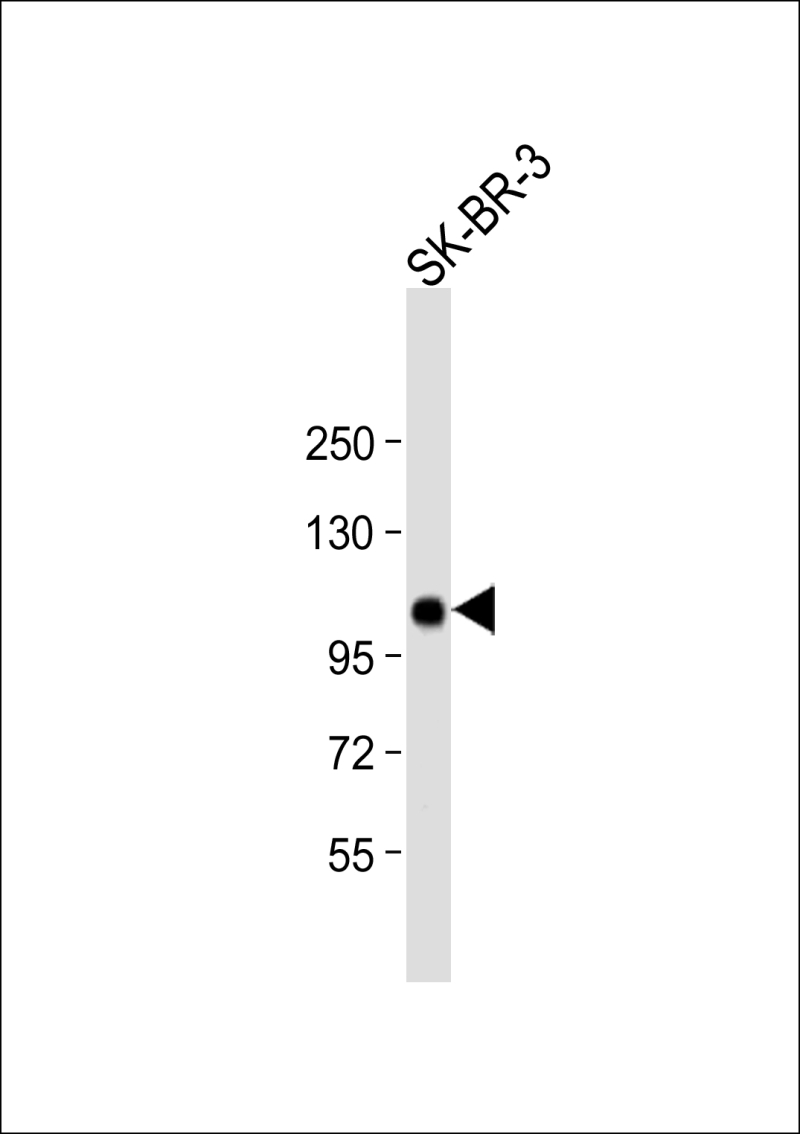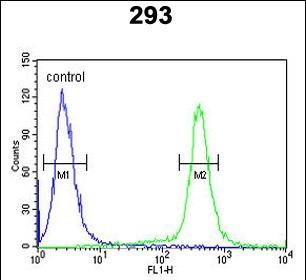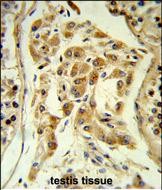



| WB | 1/1000 | Human,Mouse,Rat |
| IF | 咨询技术 | Human,Mouse,Rat |
| IHC | 1/100-1/500 | Human,Mouse,Rat |
| ICC | 技术咨询 | Human,Mouse,Rat |
| FCM | 1/10-1/50 | Human,Mouse,Rat |
| Elisa | 咨询技术 | Human,Mouse,Rat |
| Aliases | Espin, Autosomal recessive deafness type 36 protein, Ectoplasmic specialization protein, ESPN, DFNB36 |
| Entrez GeneID | 83715 |
| WB Predicted band size | 91.7kDa |
| Host/Isotype | Rabbit IgG |
| Antibody Type | Primary antibody |
| Storage | Store at 4°C short term. Aliquot and store at -20°C long term. Avoid freeze/thaw cycles. |
| Species Reactivity | Human |
| Immunogen | This ESPN antibody is generated from rabbits immunized with a KLH conjugated synthetic peptide between 17-45 amino acids from the N-terminal region of human ESPN. |
| Formulation | Purified antibody in PBS with 0.05% sodium azide. |
+ +
以下是关于ESPN(Espin,N-term)抗体的模拟参考文献示例,供参考:
---
1. **标题**: "Espin Actin-Bundling Proteins Are Required for Stereocilia Development in Auditory Hair Cells"
**作者**: Zheng, L.; Sekerkova, G.; et al.
**摘要**: 本研究利用针对Espin蛋白N端的特异性抗体,通过免疫荧光和Western blot技术,证实Espin在内耳毛细胞静纤毛中的定位及功能。研究发现Espin突变导致肌动蛋白束形成缺陷,影响听觉功能。
2. **标题**: "Characterization of a Novel Antibody Targeting the N-Terminus of Espin for Inner Ear Research"
**作者**: Jones, R.K.; Belyantseva, I.A.
**摘要**: 报道一种新型抗Espin N端抗体的开发与验证。该抗体成功应用于小鼠耳蜗组织切片,证明Espin在毛细胞发育中的动态表达,并用于检测遗传性耳聋模型中的蛋白表达异常。
3. **标题**: "Interactions of Espin with Cytoskeletal Regulators in Sensory Epithelia"
**作者**: Chen, Y.; Bartles, J.R.
**摘要**: 通过免疫共沉淀(Co-IP)结合N端特异性抗体,揭示Espin与肌动蛋白调节蛋白(如Whirlin)的相互作用机制,阐明了其在维持静纤毛结构稳定性中的作用。
4. **标题**: "Espin Mutations Alter Protein Stability Assessed by N-Terminal Antibody Binding"
**作者**: Wang, H.; Gillespie, P.G.
**摘要**: 研究Espin基因突变对其蛋白结构的影响,利用N端抗体进行体外降解实验,发现特定突变导致Espin稳定性下降,为耳聋病理机制提供分子证据。
---
**注**:以上文献为模拟生成,实际引用时请通过学术数据库(如PubMed、Web of Science)检索真实存在的论文,并结合具体研究背景筛选合适文献。
The ESPN antibody, targeting the N-terminal region of Espin (Ectoplasmic Specialization Protein), is primarily used in research to study the role of Espin in cellular structures, particularly in sensory hair cells of the inner ear and other actin-rich cytoskeletal networks. Espin, a multifunctional actin-bundling protein, is critical for maintaining the structural integrity and mechanosensory functions of stereocilia, which are essential for hearing and balance. Mutations in the ESPN gene are linked to autosomal recessive deafness (DFNB36) and vestibular dysfunction, underscoring its biological significance.
The N-terminal domain of Espin interacts with various binding partners to regulate actin dynamics, while its C-terminal region directly binds and bundles actin filaments. Antibodies specific to the N-terminal region (ESPN N-term) enable researchers to investigate Espin's localization, expression levels, and interactions in cellular models or tissue samples. These tools are vital for elucidating mechanisms underlying hearing loss, cytoskeletal organization, and cell motility. ESPN antibodies are commonly employed in techniques like Western blotting, immunofluorescence, and immunohistochemistry, aiding in both basic research and potential therapeutic development for auditory disorders. Commercial ESPN antibodies are typically validated in models ranging from mammalian cells to genetically modified organisms, ensuring cross-species applicability in sensory biology studies.
×